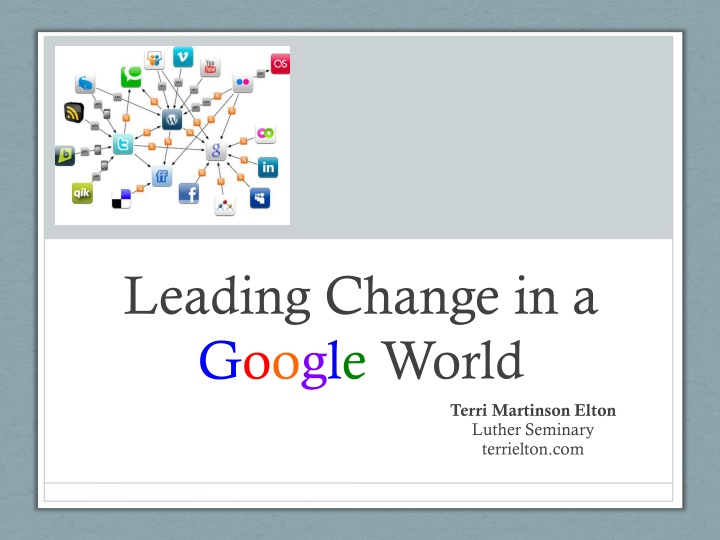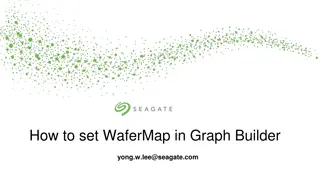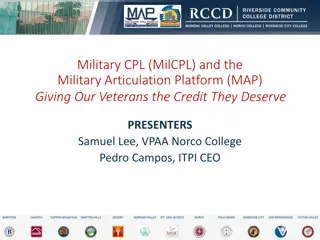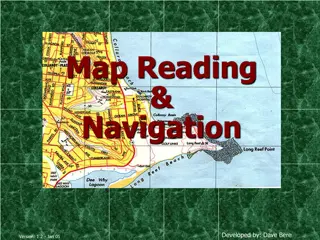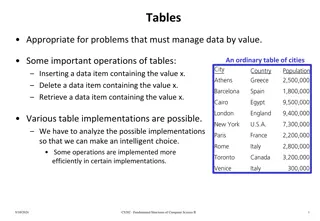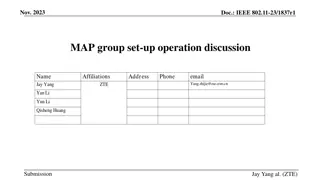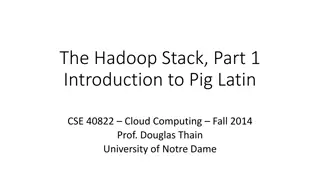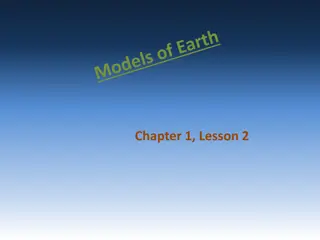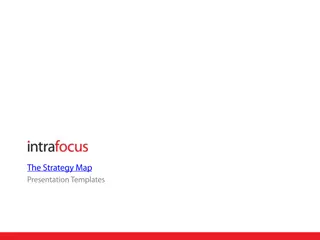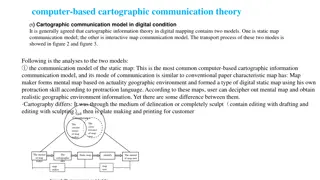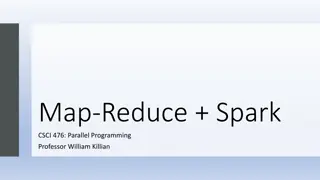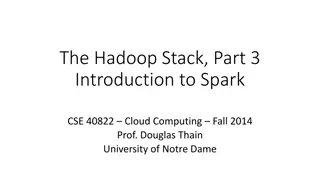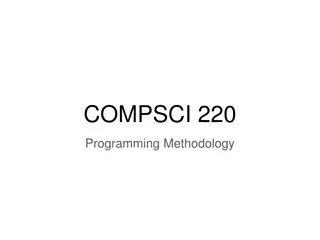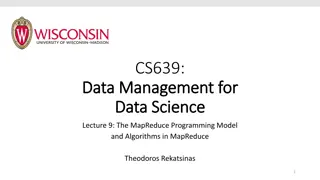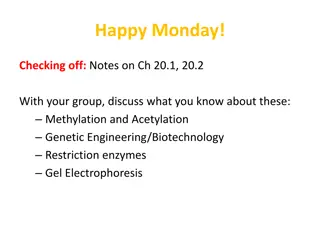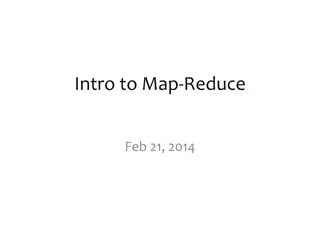Map Reduce Programming Model and Implementations
The computing world is transitioning to centralized cloud computing. Cloud computing stores, queries, analyzes, and utilizes datasets effectively. Traditional computing paradigm versus computing to data paradigm. Google's successful implementation of the data-intensive paradigm using map reduce. Introduction to the map reduce programming model.
Download Presentation

Please find below an Image/Link to download the presentation.
The content on the website is provided AS IS for your information and personal use only. It may not be sold, licensed, or shared on other websites without obtaining consent from the author.If you encounter any issues during the download, it is possible that the publisher has removed the file from their server.
You are allowed to download the files provided on this website for personal or commercial use, subject to the condition that they are used lawfully. All files are the property of their respective owners.
The content on the website is provided AS IS for your information and personal use only. It may not be sold, licensed, or shared on other websites without obtaining consent from the author.
E N D
Presentation Transcript
Leading Change in a Google World Terri Martinson Elton Luther Seminary terrielton.com
Leading Congregational Change is multi-faceted.
Leading Congregational Change is multi-faceted. It means having an eye toward the past, the present, and future. It requires drawing from and integrating theology and theory. It means being attentive to contextual realities local, regional, national, and global. It requires a knowledge base, particular skills, and certain aptitudes.
Leading Congregational Change is multi-faceted. And leading change today requires leaders be attentive to the massive cultural shifts taking place in our time.
Whats taking place today?
Almost all companies organize people in a hierarchy, and then run well managerial processes (planning, budgeting, staffing, measuring, etc.) with it. We have all seen so many hierarchical org charts and have been through so many budget, planning, and problem solving meetings, that we take all of this as a given, as if it had existed forever. In fact, it hasn t. What s taking place today? Shifting from centralized, hierarchy organizational structures toward decentralized, networked organizational structures. John Kotter, Hierarchy and Network: Two Structures, One Organization, Harvard Business Review, May 23, 2011
All of this has led me to believe that the successful organization of the future will have two organizational structures: a Hierarchy, and a more teaming, egalitarian, and adaptive Network. Both are designed and purposive. While the Hierarchy is an important as it has always been for optimizing work, the Network is where big change happens. It allows a company to mare easily spot big opportunities and then change itself to grab them. What s taking place today? Shifting from centralized, hierarchy organizational structures toward decentralized, networked organizational structures. John Kotter, Hierarchy and Network: Two Structures, One Organization, Harvard Business Review, May 23, 2011
By convergence, I mean the flow of content across multiple media platforms, the cooperation between multiple media industries, and the migratory behavior of media audiences who would do almost anywhere in search of the kinds of experiences they wanted. What s taking place today? Cultural Convergence - In the world of media convergence, every important story gets told, every brand gets sold, every consumer get courted across multiple media platforms. Right-now, convergence is getting defined top-down by decisions being made in corporate boardrooms and bottom-up by decisions made in teenagers bedrooms. Multiple Platforms Henry Jenkins, Welcome to Convergence Culture June 19, 2006
Jenkins argues that convergence represents a shift in cultural logic, whereby consumers are encouraged to seek out new information and make connection between dispersed media content. What s taking place today? Cultural Convergence - Participatory culture is intended to contrast with older notions of media spectatorship. In this emerging media system, what might be traditionally be understood as media producers and consumers are transformed into participants who are expected to interact with each other according to a new set of rules which none of us fully understands. Multiple Platforms Participatory Culture Henry Jenkins, Welcome to Convergence Culture June 19, 2006
Because there is more information out there on any given topic than we can store in our heads, there is an added incentive for us to talk amongst ourselves about the media we consume. This conversation creates buzz and accelerates the circulation of media content. Consumption has become a collective process and that s collective intelligence. What s taking place today? Cultural Convergence Multiple Platforms Participatory Culture Collective Intelligence Henry Jenkins, Welcome to Convergence Culture June 19, 2006
The bed rock of social networks is relationships. They are self-organizing, emergent, and complex. What s taking place today? Social networking sites enable many different levels and types of relationships. They encourage people who share common interests to collaborate in sharing resources and solving problems. Social networking are blind to issues of socioeconomic class, race, gender, sexual orientation, levels of education, professional titles and the list goes. In theory, social networks give individuals an equal voice regardless of difference and they enable people to transcend national boundaries. Networking Systems- Social Platforms Hayim Herring, A Preliminary Theology of Social Networks January 3, 2013
Web 2.0 describes World Wide Web sites that emphasize user-generated content, usability, and interoperability. What s taking place today? Web 1.0 Britannica Online Personal websites Publishing Directories Domain name Web 2.0 Wikipedia Blogging Participation Tagging Search Engine Optimization Solar System Networking Systems- Social Platforms Web 1.0 to 2.0 Site It allow users to interact and collaborate with each other in a social media dialogue as creators of user-generated content in a virtual community, in contrast to Web sites where people are limited to the passive viewing of content.
The networked organization is one that connects together by informal networks and the demands of the task, rather than a formal organizational structure. What s taking place today? Networking Systems- Social Platforms The network organization prioritizes its soft structure of relationships, networks, teams, groups and communities rather than reporting lines. Web 1.0 to 2.0 Network as organizational structure http://www.global-integration.com/matrix- management/networked-organization/networked- organization/
Good management can lead to failure. Sustaining technology vs. disruptive technology What s taking place today? Sustaining technology seek to improve the performance of established products, along the dimensions of performance that mainstream customers have historically valued. (xviii) Disruptive Innovation- Need for innovation Generally, disruptive technologies underperform established products in mainstream markets. But they have other features that a few fringe (and generally new) customers value. Products based on disruptive technologies are typically cheaper, simpler, smaller, and, frequently, more convenient to use. (xviii) disruptive technology is initially embraced by the least profitable customers (xx) Clayton Christiansen, The Innovator s Dilemma
Organizations capacity rest in two places processes and values. What s taking place today? The very processes and values that constitute an organization s capacities in one context, define its disabilities in another context. (xxvii) Disruptive Innovation- Need for innovation Shift in values Value networks strongly define and delimit what companies within them can and cannot do. (61) Clayton Christiansen, The Innovator s Dilemma
You cannot analyze markets that don t exist. What s taking place today? Plan for failure. Disruptive Innovation- Don t bet all your resources on being right the first time. Think of your initial efforts at commercializing a disruptive technology as learning opportunities. Make revisions as you gather data. (266) Need for innovation Shift in values Failure Clayton Christiansen, The Innovator s Dilemma
What are some ways you are seeing these shifts in your context?
What does this mean for leading congregations?
Why do you exists? Can your organization articulate your core identity and purpose? What does this mean for leading congregations? Identity and purpose provide the compass to navigate our fluid world and it is central in keeping leaders and organizations focused on their main purpose. identity clarification and understanding purpose Center-sets with the focus on the center, the boundaries are less important, and organizations can learn to govern themselves.
Agility has to do with anticipation, responsiveness in complex, changing situations and interdependent relationships. What does this mean for leading congregations? Leadership agility is the ability to take effective action in complex, rapidly changing conditions. agility - Team and organizational agility refer to the same set of capacities in teams and organizations. able to be nimble Live in a time of permanent change, demand creative thinking around deep purpose, have a broad repertoire, and resilient. ChangeWise, Leadership Agility, Team Agility, and Organizational Agility
Leaning into a decentralized, networked based world goes against the grain of established ways of working and is a threat to management practices that have existed for decades. What does this mean for leading congregations? Because this paradigm is still new, organizations will need to experiment and open themselves to learning from failures as much as successes. innovation, risk taking and experiments Freedom to experiment helps people prioritize, make decisions, and rethink how they work. Freedom to experiment helps organizations prioritize. When people are not free to experiment or take initiative, it is difficult to consider different ways of working. Jane McConnell, The Company Cultures That Help (or Hinder) Digital Transformation, Harvard Business Review, August 28, 2015
the companies that will thrive over the long term in a spreadable media landscape are those that listen to, care about, and ultimately aim to speak to the needs and wants of their audiences as crucially as they do their own business goals. (xii) What does this mean for leading congregations? Engagement is the new currency. participatory culture and meaning-making Web 2.0 is based on an architecture of participation Co-creators networked culture is giving rise to more elaborate forms of co- creation (182) Such interactions create value networks where their activities are mutually sustaining, each contributing to the value of the overall experience. (183) Henry Jenkins, Sam Ford, and Joshua Green, Spreadable Media: Creating Value and Meaning in a Networked Culture, 2013
Organizations that are responsive to the influence of the external world are more likely to understand the value digital can bring. Organizations that are open are more exposed to what is happening in the external world. They have a broader perspective helping them focus their priorities What does this mean for leading congregations? open to external world Organizations that are closed to their external world are twice as likely to report obstacles of competing priorities, slow decision- making, [and] hesitation to rethink how work is done. Jane McConnell, The Company Cultures That Help (or Hinder) Digital Transformation, Harvard Business Review, August 28, 2015
Where have you seen these elements working in other organizations? How are these elements in process in your organization?
